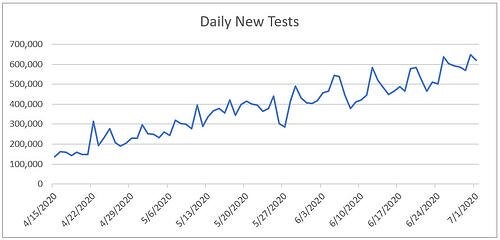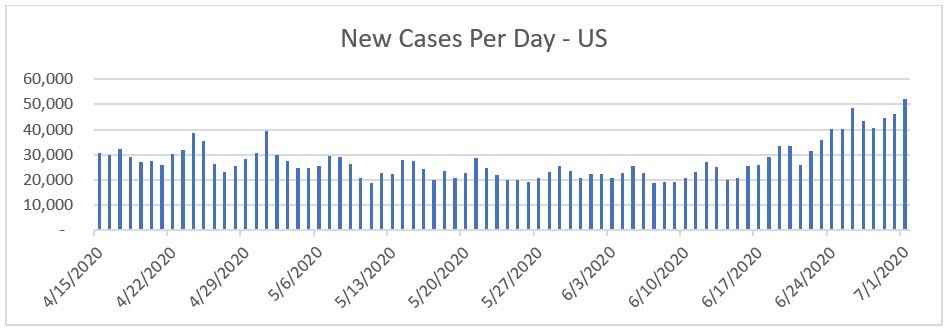Medical Risks on the Rise, but Economic Recovery Persists
Presented by CalmWater Financial Group
Over the past week, the medical risks have been on the rise. Notably, outbreaks in Arizona, California, Florida, and Texas continued to get worse. All have shown significant spikes, and now health care capacity has become a concern in some cities. Further, multiple other states have also seen expanded case growth. Nationally (as of July 1), the number of new cases broke above 50,000 for the first time, and the daily spread rate is now approaching 2 percent per day. Similarly, even as the number of tests continues to rise, the positive rate is also increasing. The breadth and magnitude of the outbreaks continue to increase the risk at a national level.
So far, however, most of the increase is still coming from a handful of states, while much of the country still has the virus under control. The four states most affected (Arizona, California, Florida, and Texas) reported 26,177 new cases, which was more than half of the total for the country as a whole. This indicates the increases in the rest of the country, while real, are much less than the headline numbers would suggest. The outbreaks, so far at least, are still geographically limited.
More, the increasingly severe outbreaks in those states and others have led them to reimpose social distancing and other restrictions. These measures should help constrain further increases. This will take time, but it should be helped as the public starts to modify its behavior. We’re seeing the same playbook that was used in New York, and it can be expected to be effective in these states as well.
Overall, the national risks are rising and the headline numbers are increasingly alarming. But the base case remains that these outbreaks continue to be localized and will be brought under control before they become national. While risks are increasing, as of now, the outbreaks are still primarily local problems and are controllable.
While the medical news has been mixed, we’ve also had good news. The economic reopening is still on track as consumers move back into the economy, and financial markets are responding to the economic news more than the medical news. Let’s take a look at the details.
The Virus: Pandemic Growth Picks Up
Growth rate. Over the past week, the daily case growth rate has trended up from 1.6 percent to 1.9 percent per day, due to significant accelerations in several states. At this rate, the case-doubling period has dropped from about 45 days to about 38 days. This rate leaves the virus under control and the curve fairly flat at a national level. But several states are now showing substantially higher growth rates that could threaten their health care systems. This is a rising risk in those states.
Source: Data from worldometer.com
Daily testing rate. Testing rates continue to increase, despite daily volatility, and are now above 600,000 per day. This is an improvement, but we’re still not yet at the level needed to develop a full understanding of the pandemic, despite the outbreaks in multiple states.
Source: Data from the COVID Tracking Project
Positive test results. We can see this lack of progress by the positive rate on tests. If we look at the percentage of each day’s tests that are positive, lower numbers are better, as we want to be testing everyone and not just those who are obviously sick. The World Health Organization recommends a target of 5 percent or lower; the lower this number gets, the wider the testing is getting. Here, we can see that the positive level has started to trend up, suggesting that we are getting back to the point of just testing the people who are sick. Again, this is likely due to the effects of the state-level outbreaks.
Source: Data from the COVID Tracking Project
New cases per day. The most obvious metric for tracking the virus is daily new cases. Due to the state-level outbreaks, the number of new cases per day has edged up to just over 50,000 per day—the highest point for the pandemic thus far and well above the range of the past several weeks. This number is somewhat better than it looks at a national level, as it includes the effects of the outbreak states. As noted earlier, the new cases are largely from the outbreak states, although the rest of the country has also shown increases in some states.
Source: Data from worldometer.com
Total active cases. Active case growth has also ticked up over the past week, and it continues to move above the prior peak. New infections are now outpacing recoveries, indicating that the burden on the health care system is getting worse.
Source: Data from worldometer.com
Major state outbreaks have risen to the level of threatening local health care systems, and case growth in other states is also picking up. Overall, while the pandemic still remains under control at a national level, the increasing breadth and speed of the state-level outbreaks are something we need to watch closely.
The Economy: Reopening Continues Despite Outbreaks
Job market. The economic news is much better. The most recent jobs report showed that, for the second month in a row, job creation was strong, with 4.8 million jobs added in June. Layoffs continued to decline, as did the continuing unemployment claims. The big news from the jobs report is not just the jobs added but also the validation that the renewed hiring is an ongoing trend and not just a one-off from last month. As this report represents actual payrolls, it is a solid indicator that the job market is now improving.
Consumers on the move. We also see this improvement in many other indicators. Consumer confidence bounced back up. And, unsurprisingly with the improvements in jobs and confidence, consumer spending also continues to recover. The chart below illustrates higher-frequency spending data. It shows consumer spending down by 8.5 percent from January, which is an improvement from the 8.9 percent decline last week. This improvement supports the retail sales report and shows that economic progress continues despite the rising infection rate.
Source: tracktherecovery.org
Finally, we can see this terrific composite of many indicators from J. P. Morgan showing the substantial recovery in many metrics, which continues despite the outbreaks.
Source: J. P. Morgan
The risks. Although the reopening is going better than expected and is clearly having some positive economic effects, we certainly face risks as we reopen. The biggest of these is if the local outbreaks turn into a national second large wave of the pandemic. At this point, that is not the most likely case, but it is a possibility.
Another potential risk is that, even with the reopening, consumers will be slow to return and spending growth will not return to what was normal any time soon. So far, this has not happened, but some of the high-frequency economic data is showing some weakening. That said, we have not yet seen a decline in spending due to the outbreaks, so the hard data remains positive.
The Markets: Volatile on Pandemic News
For the financial markets, we continue to see volatility around fears of local outbreaks going national, but markets remain supported by the ongoing positive economic news. Overall, risks do remain. But the good news is that as we get more data, markets could end up with a much firmer foundation. While the medical news has been showing rising risks, so far the economic data has been positive on the whole, and markets have responded.
Not Out of the Woods Yet
The real takeaway from this past week is that the virus continues to be the major risk. If the outbreaks continue to worsen and spread, it could put the recovery at risk—but so far we do not see that. The most likely case appears to be continued recovery, despite the rising medical risks.
Also supporting that idea is the fact that states with outbreaks are starting to take the necessary measure to control the outbreaks. While we will certainly see more damage, the playbook to bring the outbreaks under control was well established earlier in the pandemic and just needs to be implemented. As states do so, we could see the outbreaks subside.
Risks are rising, and we are not yet out of the woods. There are certainly significant risks going forward, with localized outbreaks turning into a national second wave being the most significant. At the same time, in some sense, this situation was inevitable and just part of a necessary process to figure out how to reopen effectively while still keeping the virus under control. Even as we go through that learning process (with the consequent pain), the thing to keep in mind is that many of the biggest risks are still moving behind us.
Authored by Brad McMillan, CFA®, CAIA, MAI, managing principal, chief investment officer, at Commonwealth Financial Network®.






